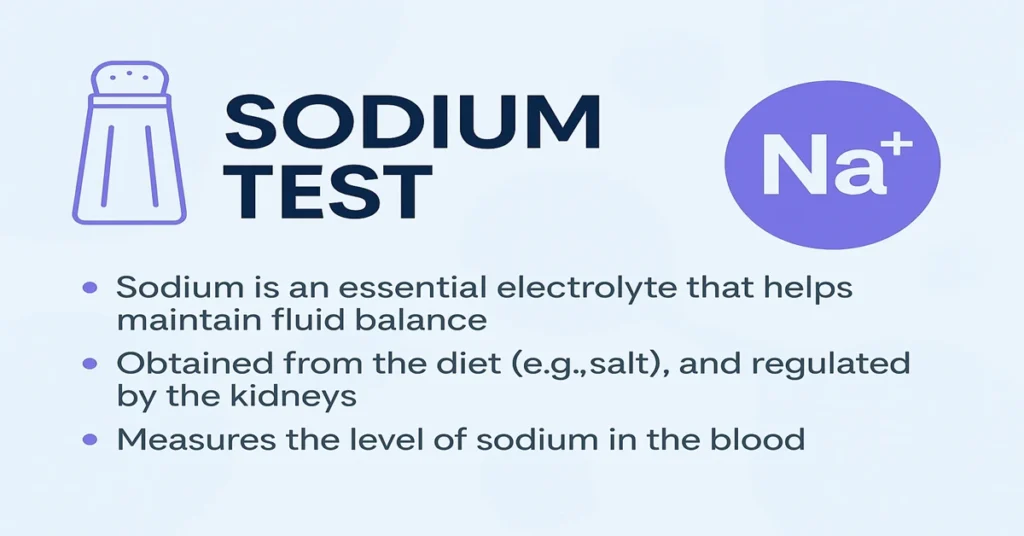What is Sodium (Na⁺)?
Sodium is an essential electrolyte and mineral that plays a major role in maintaining the balance of fluids inside and outside your body’s cells.
The sodium blood test measures the amount of sodium present in your blood. It is usually part of an electrolyte panel or basic metabolic panel (BMP), which helps check how well your body maintains fluid balance and muscle or nerve function.
Where is Sodium Produced or Synthesized?
Sodium is not produced naturally by the body.
It is obtained through your diet, mainly from table salt (sodium chloride) and other foods.
Once consumed, it is absorbed in the intestines, and the kidneys play the most important role in regulating sodium levels — either conserving it or excreting it through urine, depending on what your body needs.
Main Functions and Importance of Sodium
Sodium is vital for several body functions. Its correct balance ensures that your organs and systems work smoothly.
Some of its main roles include:
- Helps maintain fluid and electrolyte balance in the body
- Regulates blood pressure and blood volume
- Supports the proper function of muscles and nerves
- Plays an important role in acid-base (pH) balance
- Enables electrical signal transmission between cells
In short, sodium keeps your cells hydrated, your nerves active, and your blood pressure stable.
Causes of Low Sodium (Hyponatremia)
Low sodium in the blood, called hyponatremia, happens when the body has too much water or not enough sodium.
Common causes include:
- Excess fluid intake (diluting sodium levels)
- Heart failure
- Kidney disease
- Liver cirrhosis
- Syndrome of Inappropriate ADH (SIADH)
- Vomiting, diarrhea, or heavy sweating
- Use of certain medications (like diuretics and antidepressants)
Symptoms of Low Sodium
When sodium levels fall below normal, body cells swell due to water imbalance, leading to symptoms like:
- Nausea and vomiting
- Headache
- Confusion or irritability
- Muscle cramps or weakness
- Fatigue and low energy
- Seizures (in severe cases)
- Coma (in extreme or untreated cases)
Causes of High Sodium (Hypernatremia)
High sodium levels, known as hypernatremia, occur when there is not enough water in the body or when salt intake is excessive.
Common causes include:
- Dehydration
- Excessive salt intake
- Diabetes insipidus
- Fever or excessive sweating
- Burns or fluid loss
- Use of medications such as corticosteroids or diuretics
- Kidney dysfunction
Symptoms of High Sodium
When sodium levels are too high, cells lose water and shrink, causing dehydration and neurological issues.
Symptoms may include:
- Thirst and dry mouth
- Sticky tongue or dry lips
- Restlessness or irritability
- Confusion or disorientation
- Muscle twitching
- Seizures (in severe cases)
- Coma (if sodium levels become dangerously high)
Reference Ranges
| Category | Normal Range (mEq/L) | Critical Range (mEq/L) |
|---|---|---|
| Adults & Children | 135 – 145 mEq/L | <120 or >160 mEq/L |
Sample Type
- Sample Type: Serum
- Tube Used: Red Top (Plain)
A simple blood sample is required for the sodium test.
Test Preparation
- Fasting: Usually not required
- Avoid excessive salt intake before testing.
- Inform your doctor about any medications (especially diuretics, steroids, or antidepressants).
- Stay normally hydrated before the test.
When to Consult a Doctor
You should consult your doctor if you experience:
- Persistent fatigue or muscle cramps
- Frequent confusion, dizziness, or nausea
- Sudden changes in thirst or urination
- Unusual swelling or dehydration signs
Abnormal sodium levels can indicate underlying kidney, heart, or hormonal issues, so early evaluation is essential.
Important Word Explanations
- Electrolyte: A mineral in your blood and body fluids that carries an electric charge (like sodium, potassium, and chloride).
- Hyponatremia: Condition when sodium levels in the blood are too low.
- Hypernatremia: Condition when sodium levels in the blood are too high.
- SIADH: Syndrome in which too much antidiuretic hormone is released, causing water retention and low sodium.
~END~

